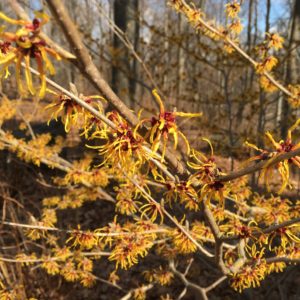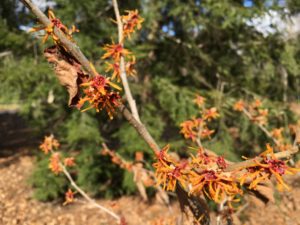Hello fellow readers, We welcome witch hazel’s winter reprieve of blooms bringing color to the predominantly white and grey landscape. They are one of the first to appear, with tiny mops of late winter blooms.
The late-winter or early-spring bloomers we see are hybrids of mostly Asian species. The native Common or North American Witch Hazel (Hamamelis virginiana) is used to make the staple astringent next to your bottle of rubbing alcohol and peroxide.
Not long ago, I visited Greenwood Gardens, a public garden in Short Hills, NJ, and drooled over two winter-blooming hybrids. A vase-shaped eight to ten-foot shrub with yellow-edged and red-centered blooms, Hamamelis x intermedia ‘Heinrich Brun’s,’ named after a German witch hazel breeder. Then there’s a reddish-orange hybrid, H. x ‘Rochester,’ that grows ten to twelve-foot-tall. Both are hardy in zones 5 to 8.
Legend has it that the Mohegans showed settlers how to use Y-shaped witch hazel sticks to find underground water. The dowsing stick bends towards the ground when underground water is detected, which may seem like a superstition. Yet Curtis Strong, harvester of 80 tons of witch hazel each year and the engineer that automated the EE Dickinson Witch Hazel plant in Connecticut, claimed he’d used the technique to accurately identify locations for twenty to thirty wells in his day.
You can use witch hazel for blemish control, heal diaper rash, shrink under-eye bags and hemorrhoids (talk about multi-tasking), soothe poison ivy, and soothe razor burn, sunburn, and dry skin or clean your dog’s ears. All of which may sound too good to be true, though it’s one of the only plants used for medicinal purposes approved by the FDA. One of the most significant benefits of witch hazel, especially those in bloom now, is lifting the winter blues.
Garden Dilemmas? AskMaryStone@gmail.com (and your favorite Podcast App.)
You can read more about Curtis Strong in The Atlantic – The Mysterious Past and Present of Witch Hazel.
Column Updated 8/1/22





Had to comment….. YES, this was the most amazing plant to stumble upon in my Rutgers horticulture days,,,,,,The winter fragrance is hard to explain, so I’ll just say…amazing !!!
Thank you, Jeff, for reminding me about the winter fragrance. A winter reprieve indeed. Here’s to spring!